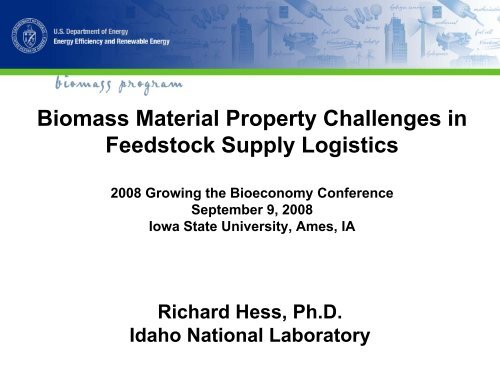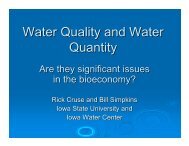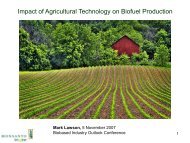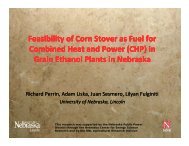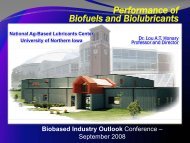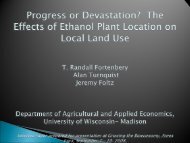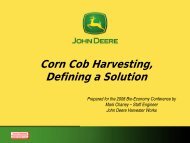J. Richard Hess - Bioeconomy Conference 2009
J. Richard Hess - Bioeconomy Conference 2009
J. Richard Hess - Bioeconomy Conference 2009
- No tags were found...
You also want an ePaper? Increase the reach of your titles
YUMPU automatically turns print PDFs into web optimized ePapers that Google loves.
Biomass Material Property Challenges inFeedstock Supply Logistics2008 Growing the <strong>Bioeconomy</strong> <strong>Conference</strong>September 9, 2008Iowa State University, Ames, IA<strong>Richard</strong> <strong>Hess</strong>, Ph.D.Idaho National Laboratory
Feedstock Logistics Cost Challenge% of Production Costs100%90%80%70%60%50%40%30%20%10%0%Corn ETOHCellulose ETOHFeedstock Logistics Conversion
Feedstock Supply Logistics BarriersFeedstock Physical Property Challenges:• Material deconstruction – changes in physical form, rheological characteristics• Product yield density – biomass format and bulk/energy densities• Moisture management – aerobic stability, post-harvest physiology, temperature impactFeedstock Equipment Engineering Challenges:• Capacity and Operational Efficiency• Dry Matter Losses (including dust collection/control)• Operational WindowInterface Challenges:• Resource Quantities/Sustainability (Feedstock Production)• Biomass Resources Physical Properties (Feedstock Logistics)• Biomass Resources Chemical Properties (Biochem and Thermochem)ResourceUniform Feedstock Supply SystemLogistics ImprovementsConversion
Conventional Square Bale FeedstockSupply SystemConventional-Bale• Same as the LivestockForage System• 10 material intermediates,3 biomass format changes• 14 process steps, 21different types ofequipment• Supply system is baleformat specific
Conventional Bale Supply SystemMonte Carlo Cost Analysis ResultsFrequency$/dry ton
10.80.60.40.20Ranking of Factors Influencing Costs inthe Conventional Bale Supply SystemBaler Field Efficiency (%) G139Harvest Window N65Field Losses % (Harvest) N66Shredder Field Efficiency (%) F84Transport Winding Factor C210Residue Removal Limit (%) C21Semi Speed (mph) E224Storage Dry Matter Loss (%) G371Transport Loader Capacity (bale/h) D235Baler Capacity (bales/h) F139Shredder Capacity (mph) D84Moisture (%) C125Bale Bulk Density (lb/ft3) E139Field Losses % (Baling) C126Relative Impact
Relationship between Herbaceous BiomassMoisture and Grinding Capacity
Relative Impact of Baling Field Losseson Supply System Unit OperationsLess than
Yield and bulk density data forlarge square balesCropYield(baledDMton/acre)DM BulkDensity(lb/ft 3 )Bales(4×4×8-ft)/AcreBales(3×4×8-ft)/AcreCorn Stover 1.6 8–9 2.8–3.1 3.7–4.2CerealStraws1.1 7–9 1.9–2.5 2.6–3.1Switchgrass 4.0 11–12 7.0–7.8 9.3–10.4Miscanthus 5.1 9–11 8.9–10.0 11.8–13.3DM Bulk Density Targets (point at which bulk density ceasesto be a predominant limiting factor) :• Transportation >16 lbs/ft 3• Handling and Storage >30 lbs/ft 3
Relative Impact of Biomass Bulk Densityon Supply System Unit OperationsLess than
Path to Uniform Feedstock SupplySystem – “Pioneer Uniform”Pioneer-UniformPioneer UniformAnalogous SupplySystem:– Sugar Beet / SugarCane SupplySystems
Path to Uniform Feedstock SupplySystem – “Advanced Uniform”Advanced-UniformBulk Solid Format:• High Bulk DensityBiomass• TorrefactionLiquid Format:• Pyrolysis Oils• other “Bio-Crude”formats
Differential Properties ofPreprocessed Biomass MaterialsFeedstock(¼-inch minus)Mean ParticleDiameterParticle SizeDistribution (wt%)Bin Density(10-ft diameter bin)Compressibility(∆% 0-500 lb/ft 2 )Switchgrass Wheat Straw Corn Stover0.276 mm 0.498 mm 0.346 mm29.4% > 0.85 mm0.212 mm < 50.7% < 0.85 mm18.6% < 0.212 mm41.6% > 0.85 mm0.212 mm < 46.9% < 0.85 mm10.3% < 0.212 mm24.9% > 0.85 mm0.212 mm < 56.1% < 0.85 mm16.9% < 0.212 mm26.1 lbs/ft 3 8.1 lbs/ft 3 9.4 lbs/ft 318% 31% 35%Flowability Factor 5.7 (easily flowing) 1.1 (cohesive) 1.2 (very cohesive)Permeability 0.27 ft/sec 0.83 ft/sec 0.18 ft/secSpringback 4.1 % 7.6 % 5.6 %Angle of Repose 33.6 degrees 35.4 degrees 35.3 degrees302520151026.1Bin Density(10-ft diameter bin)508.1 9.4Switchgrass Wheat Straw Corn Stover
PreprocessingDeconstructionCharacteristics• Different screen sizes cause adifferential rate ofdeconstruction of the material• Screen geometry directlyaffects throughput (particleescape) and spearing (loss ofsize reduction)SpearingReduced
Radiography Tests• Radiography Techniques show internal structures and potentialsource of mechanical strength/weaknessImage RadiographyEquipmentRadiograph projections ofbarley stover (left) and cornstover (right)Horizontal and verticaltomographic slices of cornstover.Un-ground corn stover left intub
Mill Design Problems DetectedImproper blade gapcreating materialhang-ups & shreddingImproper bafflingentrained particlesare not falling throughscreen
Biorefining Depends on Feedstock


